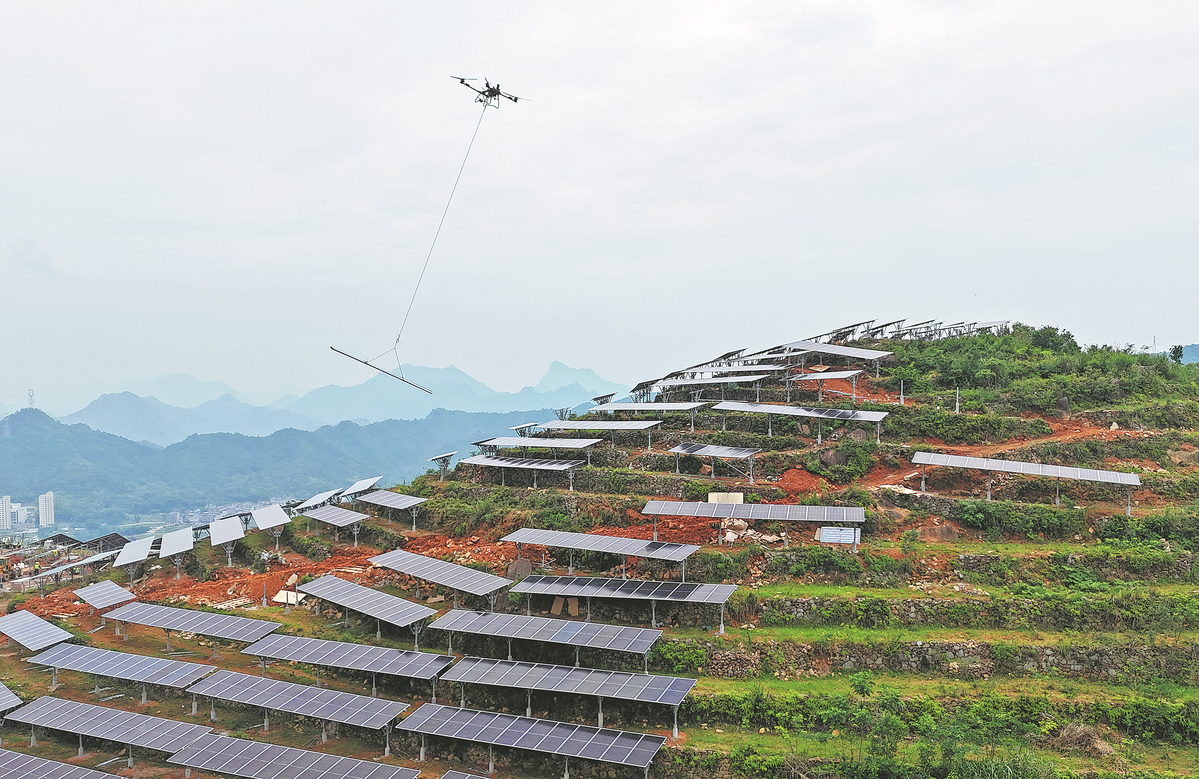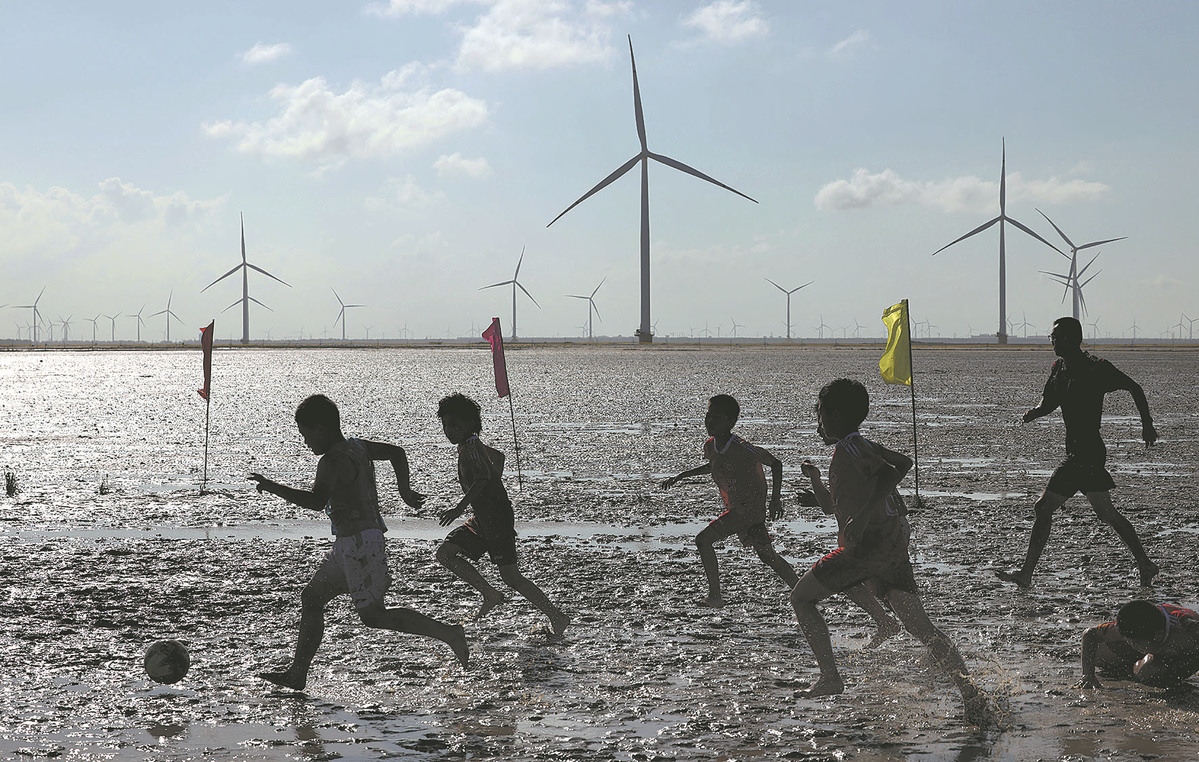Over past decade, China's share of world's clean energy capital has surged from one-quarter to one-third, underpinned by solar, wind, hydropower, nuclear, batteries and electric vehicles

China is cementing its position as the dominant force in global clean energy investment, driving down equipment costs and playing a pivotal role in the worldwide shift toward sustainable energy, according to a report released recently by the International Energy Agency.
Over the past decade, China's share of global clean energy investment has surged from one-quarter to one-third, underpinned by strategic investments in a wide range of technologies, including solar, wind, hydropower, nuclear, batteries and electric vehicles.
Its vast supply chain system has also significantly contributed to a rapid decline in global clean energy equipment prices, the report noted.
China is continuously enhancing its leadership in emerging low-carbon technologies, driving energy industry development through investments in renewable energy and improved energy efficiency, it said.
ALSO READ: SCO unites on green growth, cultural bonds
"When the IEA published the first-ever edition of its World Energy Investment report nearly 10 years ago, it showed energy investment in China in 2015 just edging ahead of that of the United States," said IEA Executive Director Fatih Birol.
"Today, China is by far the largest energy investor globally, spending twice as much on energy as the European Union — and almost as much as the EU and United States combined."
The increasing investment has further driven down costs of Chinese solar modules and wind turbines, which have fallen by 60 percent and 50 percent, respectively, since 2022, it said.
Industry experts believe technological advancements by Chinese wind and solar companies are crucial for driving down the levelized cost of electricity derived from green power, making it a more competitive and attractive energy source globally than fossil fuels.
"The relentless innovation from China's renewable energy sector is a game-changer, translating directly into lower costs and greater deployment potential, accelerating the global energy transition away from fossil fuels," said Lin Boqiang, head of the China Institute for Studies in Energy Policy at Xiamen University.
Chinese renewable energy companies' relentless focus on research and development has been widening the gap between the nation and other regions.
READ MORE: China launches green methanol bunkering at Dalian Port
Chinese solar technology giant Longi Green Energy Technology Co Ltd announced two new world records for solar cell efficiency in June, including a 33 percent conversion efficiency for a commercial-size (260.9 square centimeters) silicon-perovskite tandem solar cell and 26 percent efficiency for a crystalline silicon module, further cementing China's leading position in the global photovoltaic industry.
Li Zhenguo, founder of Longi, said the dual breakthroughs are the best proof of the company's continuous investment in R&D and its commitment to pushing the limits of efficiency.
Longi vowed to continue to drive PV to become the main source of energy globally.
Cecilia Tam, head of the energy investment unit of IEA, emphasized China's profound impact, highlighting the nation as the dominant force in global energy investment, with global trends largely dependent on the development of the Chinese market.
China, a major investor and producer of clean energy that manufactures a large volume of clean energy equipment, has been driving the application of new energy technologies in the clean energy sector at a fast pace and large scale, playing a leading role globally, said Tam.
China's successful experience in terms of policy can also accelerate the adoption of clean energy in other countries and help them build their domestic energy markets, she added.

China has recently begun construction of a hydropower project in the lower reaches of the Yarlung Zangbo River, consisting of five cascade hydropower stations with a total investment estimated at around 1.2 trillion yuan ($167.8 billion).
China Yajiang Group Co has been tasked with the smooth construction and operation of the hydropower project, which will primarily deliver electricity for external consumption while also addressing local demand in the Xizang autonomous region.
The project will leverage the Yarlung Zangbo River's extensive hydropower resources, simultaneously boosting solar and wind energy development in nearby areas to create a complementary hydro, wind and solar power base, marking a significant step in China's green energy transition.
This national push for green development is also demonstrated at the local level.
Anji county, nestled in a mountainous northern region of Zhejiang province, serves as a prime example of how China's "lucid waters and lush mountains are invaluable assets" philosophy is being translated into tangible results.
READ MORE: China earns praise for Africa's green transition
Anji has made significant strides in energy transition, with its renewable energy consumption now accounting for 30.2 percent of its total primary energy consumption, and 85 percent of its new energy consumption coming from renewables.
During the 14th Five-Year Plan (2021-25) period, Anji added 173 megawatts of PV capacity, marking a 35.3 percent growth rate.
A 115-MW agricultural-PV hybrid power project in Anji, for instance, is expected to generate 150 million kilowatt-hours annually, saving 52,500 metric tons of standard coal and reducing 104,500 tons of carbon dioxide emissions — equivalent to planting over 300,000 trees.
The benefits of this green transformation extend to ordinary citizens.
In Yucun village of Anji, the birthplace of the "Lucid waters and lush mountains are invaluable assets" theory, also known as the Two Mountains theory, residents are now fully covered by a PV carbon inclusive program, allowing them to convert rooftop solar power generation into carbon emission reductions.
These credits are then collectively traded on the carbon market, providing an average of over 400 yuan in green income per household.
This initiative, among others, underscores how the "green waters and green mountains" concept is fostering a sustainable lifestyle and shared prosperity at the grassroots level.
READ MORE: China, Russia foster green partnership
These comprehensive, multifaceted efforts, from local pilot programs to national policy directives, are emblematic of China's broader commitment to its green transition, a commitment that is increasingly shaping the global clean energy landscape.
Zhang Huiyong, executive director of international cooperation at Energy Foundation China, highlighted China's status as the world's largest clean technology investor, making energy investment particularly crucial for the country.
China's extensive experience in expanding renewable energy investment, advancing its ambitious goals of achieving carbon peak before 2030 and carbon neutrality before 2060, and navigating complex challenges, all contribute to driving global energy transformation, said Zhang.
The report also indicated a diversification in China's energy investment capital structure, with private capital increasingly flowing into the energy sector, while overseas investments are also becoming more focused on clean energy projects.
The agency predicts that global clean energy annual investment will reach $2.5 trillion by 2035, with China retaining the largest share.
As Chinese enterprises strengthen their share of overseas energy investments, particularly in the clean energy sector, "Chinese power" continues to become more prominent, it said.
Data released in the report reveals that Chinese EV and battery manufacturers have announced approximately $80 billion in investment plans over the past five years, establishing manufacturing plants in multiple countries worldwide.
Concurrently, China is also a significant investor in the global PV supply chain, with its PV industry presence becoming a crucial force in advancing global clean energy development.
Globally, energy sector investment is projected to increase by about 2 percent this year, reaching $3.3 trillion, it said, with one-third of this expected to flow into oil, natural gas and coal fossil fuels, with the remainder directed toward clean and low-carbon energy sources.
Contact the writer at zhengxin@chinadaily.com.cn


